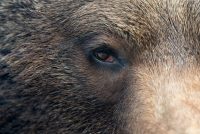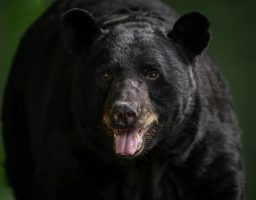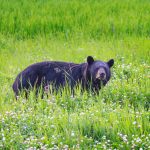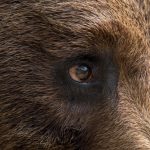Yes, Bears can actually see in color very well. After thinking that bears were short-sighted and only saw in black and white – we found out we were wrong!
How Can Bears See In Color?

All mammals have the same eye structure – and it was designed to see colors in daylight.
To do this, it has special cells – called cone cells – which detect different types of light and help create a picture in the mind from what it sees. Mammals can be either dichromats (di=two; chrome=color), trichromats (tri=three) or tetrachromats (tetra=four). Humans are in the definite tri-camp – whereas bears are in the di-camp. Both have their advantages.
Bears can still differentiate things in color – similar to domestic dogs. Mammals with a varied diet need to be able to tell if something is fresh or foul, ripe or rotten, so determining shades of color is a major part of that. Bears eat a lot of fruit and berries – so their color is just as important as it is with primates. Yes, their sense of smell is very important too – but the visual appearance is something that helps make the final decision.
People used to think that because they smelled so well – bears were probably color blind or only saw in black and white. Rather a strange assumption to make – but never-the-less proved wrong by experiments in zoos. Keepers put treats in sniff-proof containers of different colors and most types of bears were able to pick the one with the treats based on color alone more times than chance would allow.
Are Bears Attracted To Certain Colors?

Just like with bulls – there are often myths built up around which colors attract bears and which could ward off a bear attack. However, just like with bulls (who can’t actually see the color red at all) this connection was disproven time and again.
Bears are inquisitive – and greedy – so are more likely attracted to camps and tents by the smell more than anything. They may have smelled your dinner cooking hours ago and have walked a great distance to find it. Then when they stumble into camp – they may walk towards things that they can see most clearly – having probably learned from previous interactions that tents mean food.
Camouflage or more natural tent colors are less likely to attract attention visually – but if they don’t smell of food – the bear won’t pay attention most likely anyway. It might just come down to the fact that more bear-savvy campers go camo, so the tent color isn’t the issue; it is the accidental cookies left by rookies that are the key difference.
Bright clothing however is to your advantage in any outdoor habitat as not only can animals see you coming a mile away – you will also be found more easily if you do get yourself into any trouble. Accidently creeping up on a bear in camo clothes is probably the worst thing you could do – but a noisy group of people in bright colors – now that should scare the bears away!
Can Bears See In The Dark?
As with most crepuscular animals (those who have evolved to be active at dusk and dawn), bears have a trick up their sleeve. Not only do they have rod cells in their eyes (just like us humans do) to see in low light levels – they also have a tapetum. Just like a cat.
Article: Do Bears Have Nightvision?
This extra-special membrane at the back of the eyeball allows any light at all in the environment to shine back through the eye twice. The light shines in through the front and then reflects back out again – picking up even more light with which to see. This reflection has the color yellow – and so at night, a bear’s eyes will shine yellow at you in the torch.
Different animals shine back different colors – so that can help identify things out in the wild. Pretty handy to know if it is a bear staring at you in the dark or a cat? However, both cats AND bears can see better than us at night (especially if our own bright torch has just reset our rod cells to zero), so best get a green or red wavelength torch instead for that next camping trip.
Does a Bear’s Ability to See In Color Affect Its Jumping Ability?
Does a bear’s ability to see in color affect its jumping ability? It’s a common curiosity to wonder just how high can a bear jump?. While a bear’s vision may be limited to shades of blue, bears possess remarkable jumping skills. Due to their powerful muscles and strong legs, bears can effortlessly soar great heights, impressing us with their remarkable agility.
Are Bears Short-Sighted?

No, it’s another myth. Bears don’t like to make eye contact – as in the bear world this is a sign of a threat. And as bears really don’t want to have a fight with anyone if they can really help it – they look away and walk on. This was believed to mean they couldn’t really see you.
However, they probably smelled you approaching this way about an hour ago. If they weren’t too fussed about you in their neck of the woods – they won’t really be that surprised to see you (unlike you to them) – no need to stare. So, you catch their eye for a second, then they just carry on whatever they were doing.
And believe us, this is what you want them to do!









